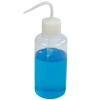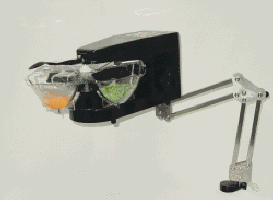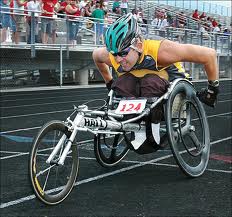Mealtime Partners, Inc.
Specializing in Assistive Dining and Drinking Equipment
June 2013 Independent Eating and Drinking Newsletter

|
June Topics:
|
||
|
Mealtime Partners Home Page Send a Comment or Suggestion |
|||
| Subscribe to Newsletters |
How to Overcome Developmental Disabilities that Effect Independent Drinking
According to the Centers for Disease Control and Prevention (CDC) developmental disabilities are a group of conditions due to an impairment in physical, learning, language, or behavior areas. About one in six children in the U.S. have one or more developmental disabilities or other developmental delays. The federal definition is explained in the Developmental Disabilities Assistance and Bill of Rights Act of 2000 which defines developmental disabilities as disabilities that are chronic and have an onset prior to age 22. The bill of rights was implemented to improve service systems for individuals with developmental disabilities, and includes protection and advocacy services, employment support and assistance, and family and community services and support.
Disabilities can occur in one or more areas of development including: social, emotional, language acquisition (speech & comprehension), cognition (learning, thinking, problem-solving), movement, and physical development.
Causes and the results of developmental disabilities are numerous, but some of the more familiar are: Cerebral Palsy (CP), Autism Spectrum Disorders, Fetal Alcohol Syndrome, Muscular Dystrophy (MD), and Downs Syndrome. Regardless of the disability it can impact the child in a broad spectrum of severity from mild to profound. Children who are mildly affected by a disability are likely to be able to perform all activities of daily living unassisted by the time they reach adolescence. For those severely impacted, mastery of independent dressing, bathing, toileting, eating, etc. may be a life-long challenge that cannot be mastered, or may always need some, or considerable, assistance.
In this Newsletter article we will emphasize developmental disabilities that effect drinking and will describe some strategies for teaching drinking skills to small children who are unable to progress naturally. Specifically we will discuss children who aspirate, evolving from a bottle to a cup, and teaching children without the use of arms and hands, how to use a straw to gain independence in drinking.
Drinking is typically one of the earliest functions in which an infant participates. It may be drinking from a breast or bottle but normal development allows a baby to “know” how to suck and swallow, and with very little practice they become competent. However, many infants, particularly those born prematurely, do not have the opportunity to drink immediately after birth as they are underdeveloped or have other health/development issues that must be addressed. The natural development of drinking skills is delayed for these children. Most receive nutrition through a tube placed through their nose and esophagus into their stomach. This is known as a nasogastric tube or NG tube. Many premature babies grow and develop and gradually begin to drink by mouth. For other babies who have substantial health difficulties, the introduction of oral drinking may be delayed for a significantly long time.
Aspiration. For many children for whom drinking is delayed, sucking and swallowing are not necessarily natural or easy to perform. One of the common problems is the inability to swallow safely. When liquid is taken into the mouth, if the swallow is not well coordinated, the liquid can be inhaled into the respiratory system (pulmonary aspiration). (Our February 2013 Newsletter discusses pulmonary aspiration in detail if more information is desired.) If aspiration is identified, drinking by mouth should be avoided until a strategy has been developed that can avoid the risk of aspiration.
Some of the common approaches to reduce the risk of aspiration are to thicken liquids, to control the volume of liquid being offered for each swallow, and to have the infant or small child in a more upright position than is typical for that age. However, once aspiration has been identified as a reoccurring problem, drinking and eating should be supervised by a medical team that includes a speech pathologist who specializes in resolving eating and drinking problems.
Drinking from a Cup. For those infants who are able to suck and swallow but are unable to coordinate their hand and arm movements, picking up and holding a drink is a problem. It is accepted that an infant will be given a bottle and the caregiver will hold it for them and that they will gradually begin to hold the bottle for themselves.
When evolving from a bottle to a cup, the type of cup selected varies depending upon the parent, society, and economics. Most infants in the US are provided a “Sippy” cup as their first cup that they hold for themselves. Sippy cups reduce the amount of liquid that is dispensed when the cup is tipped. It also has a tightly fitted lid that stops liquid from being spilled. Initially, the caregiver still holds the cup, but over time the child should hold and tip it for themselves. The spout on a Sippy cup is similar to drinking from a nipple and, therefore, is a good starting point for learning to use a cup. Children should progress from a Sippy cup to a regular tumbler shaped cup with an open top to develop their skills and coordination. Drinking from a straw should also be learned as straw drinking uses different muscles than are used when drinking from a bottle or cup. These muscles are used for chewing and also are an integral part of speaking clearly.
For the child who cannot grasp or move their hands and arms in a coordinated way the evolution from bottle to cup cannot progress as it does in a typical developing child. For children who do not have mastery over hand and arm control, independent drinking is limited by the inability to pick-up, hold, and tip a cup. For children who have this limit, drinking through a straw becomes an essential part of learning to drink without help.
Learning to Drink using a Straw (or tube). Some children learn how to suck through a straw relatively easily; for others it is more difficult, or impossible, due to poor coordination and/or poor suction. Many parents teach their infants to drink through a straw by putting the straw in liquid and then putting their finger over the open end of the straw, as illustrated in the picture below.
In this way a small amount of liquid is held in the straw by a vacuum. The end of the straw that was in the liquid can be placed in the child’s mouth and the parent’s finger removed. The liquid runs down the straw into the mouth. Most babies will close their lips around the straw as they have learned to do around a nipple. With closed lips a natural vacuum is formed when the liquid is swallowed. Once the infant has learned to close their lips around the straw, the same process of dipping the straw into a cup of liquid and then putting a finger over the end, can be performed. This time the finger should not be removed until the child sucks and pulls the liquid into their mouth. With practice, this process evolves into drinking through a straw.
However, if a child is unable to develop the ability to drink through a straw in this way, other strategies are available. For example, a laboratory wash bottle can be used, as pictured below.
 |
 |
| Liquid in a Straw | Laboratory Wash Bottle |
Similar to the lab bottle, a honey bear bottle with a straw or several commercially available straw cups work well, but the volume of liquid dispensed is not as easy to control as when using the laboratory wash bottle.
Prior to teaching a child how to drink through a straw using a laboratory wash bottle as a tool, fill the bottle about half full with water and practice gently squeezing the bottle until a few drops of liquid are reliably dispensed with each squeeze. Once control over the volume of liquid that is dispensed is accomplished, it can be introduced to a child. If the child is nervous about new things, it is wise for the adult to demonstrate drinking from the bottle to the child prior to the child doing so. To start the process, the tip of the tube should be placed in the pocket of the child’s cheek and the tube should rest at the corner of the mouth. Once in place, if the child does not close their lips naturally, the lips should be gently closed and held shut. Dispense a few drops of liquid into the child’s cheek and wait. The liquid will be swallowed and once a swallow has occurred, the process should be repeated. Over time a vacuum will occur in the mouth and the liquid from the bottle will be pulled up into the child’s mouth. The next swallow will trigger suction and the process of drinking through a straw has begun. This may take a lot of practice before mastery is achieved. However, for a child who lacks hand function, it is an important part of developing the ability to drink independently.
Independent Drinking. Once drinking through a straw is mastered there are several cup holders that can be mounted to hold a drink with a straw in it near the child’s mouth such that they can take a drink whenever they want to. By developing this ability, the child gains independence and the concept of autonomy which will benefit them throughout their life.
Mealtime Partners offers a variety of hands-free drinking systems. The Front Mounted Drinking System is very appropriate for use by small children as it can be positioned appropriately for them and can hold a wide range of drink containers. Similarly, the Mealtime Partners Hydration Backpack with Drink Tube Positioning can make water available to them for long periods of time with little caregiver attention for providing liquids. To learn more about all of the Mealtime Partners Drinking products, including cups, click here.
| The Mealtime Partner Can Be Used as a Developmental Aid | |
When it becomes apparent that a child will not develop the fine or gross motor skills to be able to self-feed, using a Mealtime Partner Dining System to assist him/her in eating can help them to master the fundamental eating skills during a more appropriate time frame and accelerate the development of other functional skills. It can also help to avoid learned dependence, and, at an early age, teach them that they can have some control over their lives, regardless of their disabilities. The Mealtime Partner is the only powered assistive dining device that can be used by small children. It has been proven to work with children as young as three years old. |
|
| Because proper positioning is so important to independent (and safe) eating, Mealtime Partners, Inc. offers several mounting systems for the Mealtime Partner Dining System. Not only can the device simply sit on a table for use, but its height can be adjusted (for table use) by mounting the device on legs of several lengths. For those who sit in a wheelchair to eat, the device can be mounted on a mounting shaft or on its Support Arm. Flexible mounting methods available for the Mealtime Partner Dining System facilitates positioning the Mealtime Partner in a comfortable position to eat for almost any user. |
 The Mealtime Partner Mounted on a Support Arm |
| For individuals who have limited range of upper body control or who fatigue easily from the effort of controlling their body movement, it is recommended that they use the Mealtime Partner mounted on the Support Arm because it has infinitely variable positioning (within its total range). For more information about the Mealtime Partner Dining System, click here. | Click the following link for prices and
for ordering the
Mealtime Partner Dining System.
An appropriate hands-free drinking system should also be
considered. |
| The Mealtime Partner Dining System is made in the U.S.A. by Mealtime Partners, Inc. | |
Putting Your Best Foot Forward
The expression “putting your best foot forward” has several meanings but the most common meaning is to do something as well as you possibly can. The saying originated from the days when ladies curtsied and men bowed. To make sure that their children made the best possible impression, parents taught their children to put their “best” or dominant foot forward when they curtsied or bowed. Thus they would be able to control their movements, be stable, and bow or curtsy deeply because their weight was on their dominant foot.
For those who are unable to walk, it is difficult to put their best foot forward when undertaking tasks. However, it is essential to have ones feet in the best position for weight bearing when coordinated movement is needed, regardless of whether you are standing or sitting. Without the feet being well supported, the rest of the body is unstable which makes executing a task more difficult. Wheelchairs typically have foot supports that are positioned to hold the feet with a 90-degree angle at the ankle. The feet are also positioned so that the knees are at a 90-degree angle and the hips and thighs are at a 90-degree angle. This position is designed for mobility. Whether the wheelchair is powered and driven by its user or being pushed by another person, the occupant is moving from place A to place B. In this position, they are able to see where they are going and rest their head against a head rest (if one is mounted on the wheelchair). However, if the occupant is physically moving the wheelchair using their arms, their positioning will be different. Their legs will be supported at a level that gives them support for moving their chair. This leg and foot positioning is of even greater importance for someone racing in a wheelchair. In fact, their legs are tightly tucked into the body to allow full arm movement around the wheels and good trunk stability. In each case their feet are positioned to support the task that they are undertaking.
 |
 |
| Man Racing in Wheelchair | Positioning in Manual Wheelchair |
This simply illustrates how important it is to the execution of a specific task to have the feet and legs in an appropriate position. Each task uses different muscles and the body’s weight bearing position needs to adjust to meet the needs of the task.
For eating, the feet, thighs and buttocks all need to fully bear weight. In a wheelchair, the foot plates may not provide the correct position to facilitate this weight bearing. In this case the foot plate should be raised at mealtime. To quickly and easily make this change without modifying the wheelchair (or using tools), paperback books can be used to lift and support the feet. Make sure that the correct thickness of book is used and wrap them in duct tape so that they won’t tear. Then wrap a Velcro strap around the book and foot plate to hold it in position during the meal. (It is also wise to clearly label the “books” so that they don’t get thrown away when not in use.)
Eating can be executed more efficiently and safely when the feet are in the right place. Having a firm platform for the body allows all of the muscles involved in the task of eating to function better and in a more coordinated fashion.
Whether eating by hand, being fed, or using assistive technology like the Mealtime Partner Dining System, stable positioning with good foot support will allow for more coordinated oral motor movements, and better processing of food from the mouth to the stomach. Poor positioning will increase the likelihood of choking, aspirating and reflux. Therefore, it is important to maintain the safest possible mealtime positioning.
| Did You Know? Did you know that the American Cancer Society is celebrating its 100 birthday this year? At the time it was formed, the biggest killers in the US were influenza, pneumonia, tuberculosis, and stomach bugs. The average life expectancy was 47 and few people lived long enough to actually develop cancer. Despite this, a group of doctors and businessmen in New York thought that cancer deserved to be studied and formed the Society. As the control of infectious diseases developed people began to live longer and cancer became more common as “it is a disease of aging”, according to Dr. Michael Kastan, executive director of Duke University's Cancer Institute. In 1938 cancer became the number 2 cause of death in the US, a ranking that it has maintained since that time. However, the American Cancer Society reports that the incidence of new cancer cases has reduced by approximately half a percent each year starting in 1999. |
Mealtime Partners Website Navigation:
Home | Dining | Drinking | Videos | All Products | Warranty | Ordering | Calendar | FAQ | Newsletters | Contact
Please send comments and suggestions to newsletters@mealtimepartners.com
Copyright © Mealtime Partners, Inc. 2013
All rights reserved.